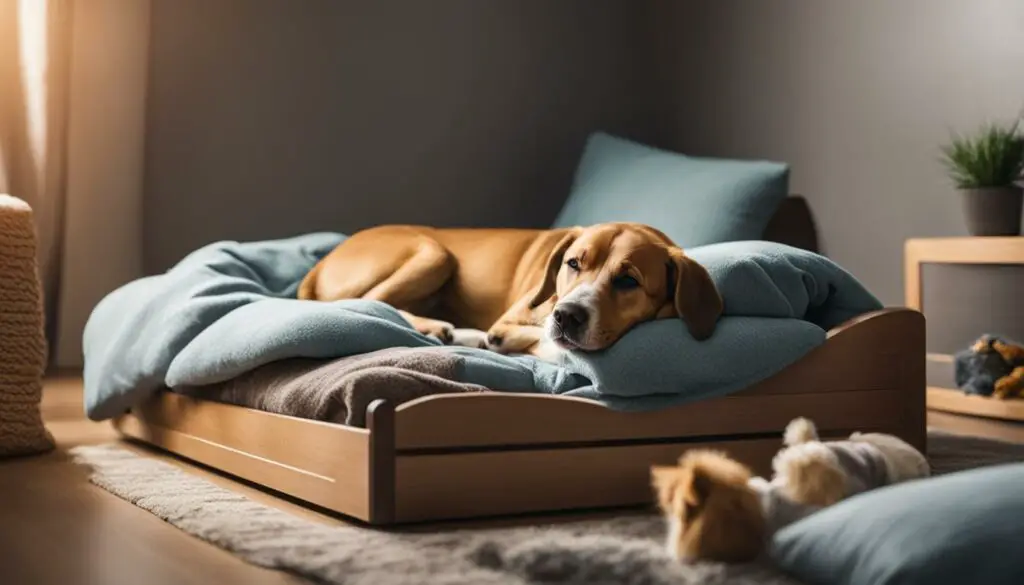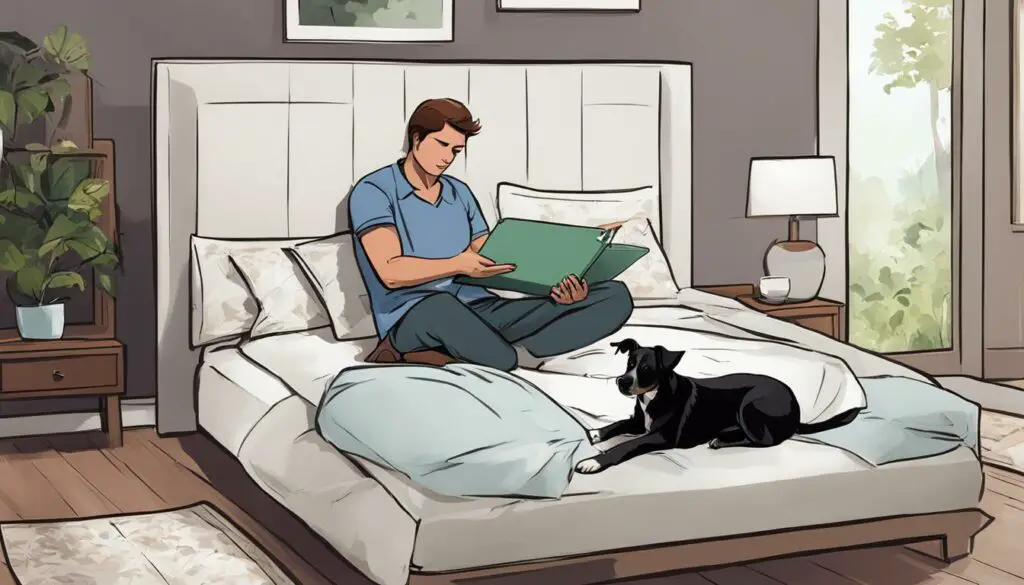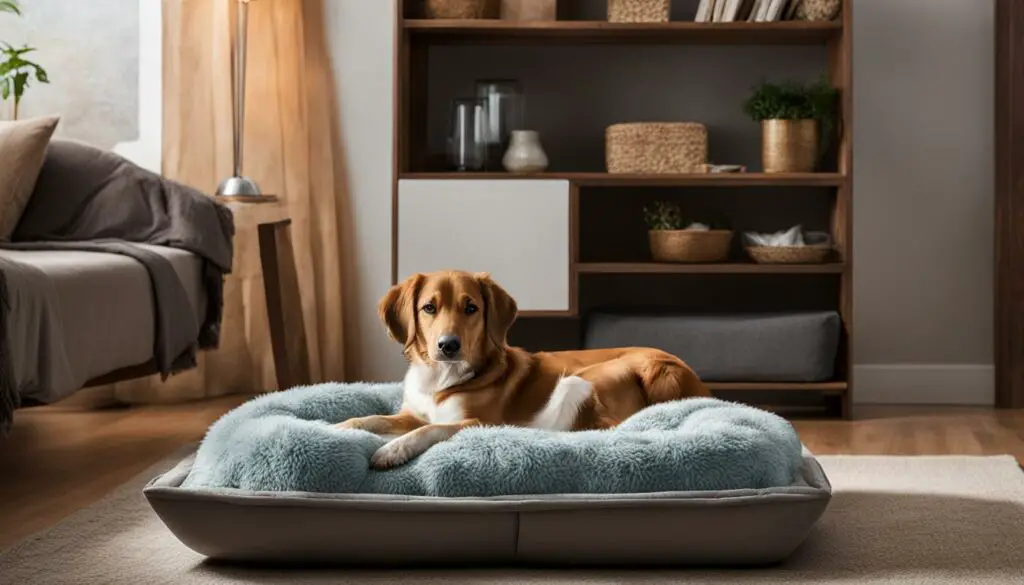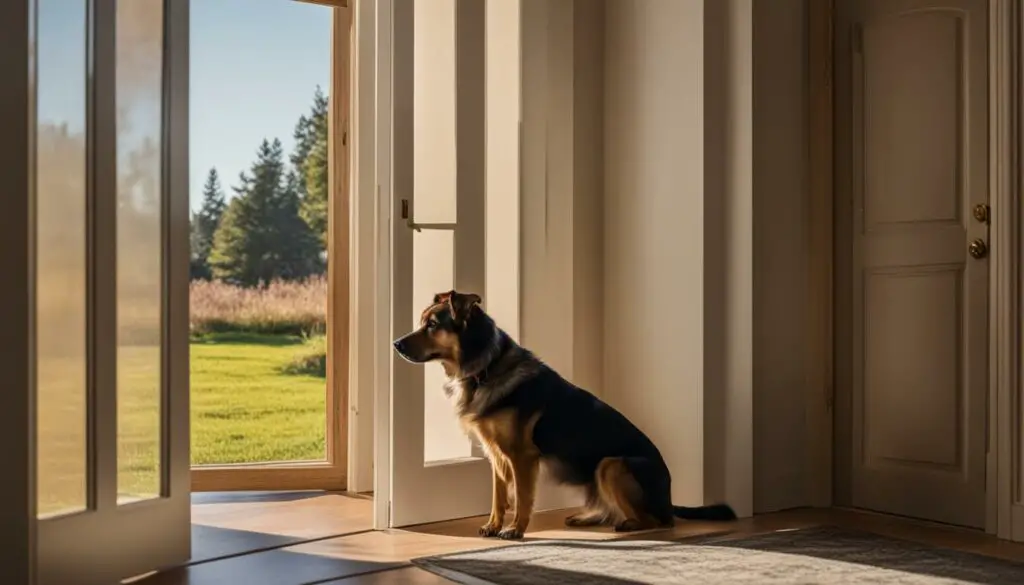Transitioning your dog out of the bedroom can be a challenge. With the right training techniques and a consistent approach, you can successfully create a new sleeping routine for your pup. It’s important to understand your dog’s behavior and modify it to help them adjust to sleeping outside the bedroom.
Key Takeaways:
- Understand your dog’s behavior and modify it to help them adjust to sleeping outside the bedroom.
- Choose the right dog bed considering your dog’s size, weight, age, and any orthopedic issues they may have.
- Gradually increase the amount of time your dog spends in the new sleeping area to help them adjust.
- Address separation anxiety by gradually increasing the time spent apart and providing interactive toys and comfort items.
- Establish a consistent bedtime routine to help your dog relax and prepare for sleep.
Why Do Dogs Sleep in Bed?
Dogs often choose to sleep in bed with their owners because they feel safe and want to be close to their pack leader. It’s a natural instinct for dogs to seek the comfort and companionship of their human family members, especially during sleep. Sleeping in bed with their owners allows dogs to feel secure and protected, just like they would in a pack in the wild.
Additionally, dogs can form strong bonds with their owners and sleeping in bed together can strengthen that bond. It provides an opportunity for physical closeness and the shared warmth can be comforting for both parties. Dogs are social animals and being close to their owners while sleeping can also help reduce separation anxiety and create a sense of security.
While it’s perfectly fine for your dog to sleep in bed with you, it’s important to set boundaries and establish their own sleeping space. By providing a comfortable and inviting dog bed, you can encourage your dog to develop healthy sleeping habits and gradually transition them out of the bedroom if desired.

Why Do Dogs Sleep in Bed?
There are several reasons why dogs may choose to sleep in bed with their owners:
- They feel safe and want to be close to their pack leader.
- The companionship and physical closeness strengthen the bond between the dog and their owner.
- Sleeping in bed together can help reduce separation anxiety and create a sense of security.
While allowing your dog to sleep in bed with you is a personal choice, it’s important to establish boundaries and provide them with their own comfortable sleeping space. This can help promote healthy sleeping habits and ensure a restful night’s sleep for both you and your furry companion.
Benefits of Establishing Boundaries
Setting boundaries and establishing your dog’s own sleeping space can have several benefits:
- Helps maintain a healthy sleeping environment for both you and your dog.
- Prevents dominance behaviors and reinforces your role as the pack leader.
- Enables your dog to develop independence and self-soothing abilities.
- Reduces the risk of sleep-related accidents or disturbances.
By providing a comfortable dog bed and gradually transitioning your dog out of the bedroom, you can create a new sleeping routine that promotes your dog’s well-being while respecting your own personal sleeping preferences.
| Reasons Dogs Sleep in Bed | Benefits of Establishing Boundaries |
|---|---|
| Feeling safe and close to their pack leader | Maintains a healthy sleeping environment |
| Strengthening the bond with their owner | Prevents dominance behaviors |
| Reducing separation anxiety | Develops independence and self-soothing abilities |
Choosing the Right Dog Bed
When it comes to transitioning your dog out of the bedroom and creating a new sleeping routine, choosing the right dog bed is essential. Your dog’s bed should provide comfort, support, and a sense of security. Consider the following factors when selecting a dog bed:
- Size: Ensure that the bed is appropriate for your dog’s size and breed. It should be large enough for them to stretch out comfortably.
- Orthopedic Needs: If your dog has orthopedic issues or is a senior, opt for a bed with memory foam or other supportive materials to relieve pressure on their joints.
- Washable: Look for beds with removable, machine-washable covers to make cleaning easier.
- Chew-Resistant: If your dog tends to chew on their bed, choose a durable and chew-resistant material to prevent damage.
It’s also important to let your dog try out different beds and select one that they find comfortable and enticing. Each dog has its own preferences, so consider their sleeping behavior and habits when making your choice.

Remember, the goal is to provide your dog with a safe and comfortable space to sleep outside the bedroom. By choosing the right dog bed, you can help them feel secure and encourage a smooth transition.
Teaching Your Dog to Sleep in a Different Room
Transitioning your dog out of the bedroom can be a challenge, but with the right training techniques and a consistent approach, you can successfully create a new sleeping routine for your pup. One effective strategy is to gradually teach your dog to sleep in a different room. Here are some training techniques to help you in the process:
1. Set up a comfortable sleeping area
Start by creating a cozy and inviting sleeping space in the new room. Choose a comfortable dog bed that suits your dog’s size, weight, and sleep preferences. Make sure the area is free from any distractions that may disrupt your dog’s sleep.
2. Use positive reinforcement
Positive reinforcement is a powerful training tool that involves rewarding your dog for desired behaviors. When you introduce your dog to their new sleeping area, use treats, praise, and affection to create a positive association. Gradually increase the time your dog spends in the new room, offering rewards and encouragement along the way.
3. Maintain consistency
Consistency is key when training your dog to sleep in a different room. Stick to a regular sleep schedule and be consistent with the rules and boundaries you set. Avoid allowing your dog back into the bedroom once you’ve made the decision to transition them out. This will help them understand and accept their new sleeping arrangement.
| Training Techniques | Benefits |
|---|---|
| Positive reinforcement with treats and praise | Creates a positive association with the new sleeping area |
| Gradual transition | Allows your dog to adjust to the new routine at their own pace |
| Consistency with sleep schedule and boundaries | Helps your dog understand and accept the new sleeping arrangement |
Remember, every dog is unique, and the time it takes for them to fully adjust may vary. Be patient and understanding throughout the process, offering support and reassurance to your furry friend. By using positive reinforcement and maintaining consistency, you can successfully teach your dog to sleep in a different room and establish a new sleeping routine.
Managing Separation Anxiety
When transitioning your dog out of the bedroom, it’s common for them to experience separation anxiety. Separation anxiety can manifest in various ways, including excessive barking, destructive behavior, and even self-injury. To help your dog adjust to sleeping outside the bedroom and alleviate separation anxiety, there are several strategies you can try.
Gradual Separation
One approach is to gradually increase the amount of time you spend apart from your dog. Start by leaving them alone in their new sleeping area for short periods, such as a few minutes, and gradually extend the duration. This will help them get used to being separate from you and reduce their anxiety over time.
Interactive Toys and Comfort Items
Providing your dog with interactive toys and comfort items can also help alleviate separation anxiety. Toys that require mental stimulation, such as puzzle toys or treat-dispensing toys, can keep your dog occupied and distract them from feeling anxious. Comfort items, such as a blanket or a piece of clothing with your scent on it, can provide them with a sense of comfort and security.
Professional Help
If your dog’s separation anxiety persists or worsens despite your efforts, it may be beneficial to seek professional help from a dog trainer or behaviorist. They can assess your dog’s specific needs and provide tailored strategies to manage and reduce their anxiety. Professional guidance can be particularly valuable for dogs with severe separation anxiety or complex behavioral issues.
Conclusion
Transitioning your dog out of the bedroom can be a challenging process, especially if they experience separation anxiety. By gradually increasing separation time, providing interactive toys and comfort items, and seeking professional help if needed, you can help your dog adjust to sleeping outside the bedroom and manage their separation anxiety effectively.
Creating a Bedtime Routine
Establishing a bedtime routine for your dog is essential in changing their sleeping habits and ensuring a peaceful night’s sleep. By following a consistent routine, you can help your furry friend relax and prepare for restful slumber. Here are some tips to guide you in creating an effective bedtime routine:
1. Wind Down with Calming Activities
- Take your dog for a leisurely walk in the evening to tire them out physically.
- Engage in low-key playtime, such as gentle fetch or puzzle toys, to stimulate their mind.
- Consider incorporating calming exercises, like gentle massage or deep breathing exercises, to help your dog relax.
2. Create a Cozy Sleeping Environment
Designate a comfortable and inviting sleeping area for your dog. Choose a quality dog bed that matches their size and provides adequate support for their body. Make sure the sleeping area is cozy and free from distractions that may disrupt their sleep.
3. Establish a Bedtime Ritual
Develop a routine that signals to your dog that it’s time to sleep. This can include activities such as brushing their fur, offering a bedtime treat, or providing a favorite blanket or toy. Consistency is key, so try to perform these actions in the same order every night.
Remember, every dog is unique, so it may take some trial and error to find the perfect bedtime routine that works for your furry companion. Observe your dog’s behavior and adjust the routine as needed. With patience and consistency, your dog will gradually adapt to their new sleeping habits and enjoy a good night’s rest.

| Benefits of a Bedtime Routine for Your Dog | Tips for a Successful Bedtime Routine |
|---|---|
|
|
Addressing Sleep-Related Issues
When transitioning your dog out of the bedroom, you may encounter certain sleep-related issues that need to be addressed. Understanding and addressing these problems is crucial for creating a successful sleeping arrangement for your pup. Here are some common sleep-related issues and how to modify your dog’s sleeping behavior:
Sleep Disturbances
Some dogs may experience sleep disturbances when transitioning to a new sleeping area. This can include difficulties falling asleep, frequent waking up during the night, or restless sleep. To address these issues, create a calming bedtime routine that helps your dog relax before sleep. This can include gentle exercises, such as stretching or massage, as well as playing soothing background music or using aromatherapy. Additionally, ensure your dog’s sleeping area is comfortable, quiet, and free from distractions that may disrupt their sleep.
Anxiety or Fear
Transitioning out of the bedroom can sometimes trigger feelings of anxiety or fear in dogs. They may feel insecure or uncomfortable sleeping in a new space, especially if they have been accustomed to the bedroom for a long time. To help your dog feel more at ease, gradually introduce them to their new sleeping area by spending time with them in that space during the day. Use positive reinforcement techniques, such as treats and praise, to create a positive association with the new sleeping area. If your dog’s anxiety or fear persists, consult with a professional trainer or behaviorist for additional guidance.
| Sleep-Related Issue | Modification Technique |
|---|---|
| Sleep Disturbances | Create a calming bedtime routine; provide a comfortable and distraction-free sleeping area |
| Anxiety or Fear | Gradually introduce the new sleeping area; use positive reinforcement techniques; seek professional guidance if needed |
| Restlessness | Ensure your dog gets enough physical and mental exercise during the day; provide a cozy and secure sleeping environment |
Restlessness
Some dogs may exhibit restlessness when transitioning to a new sleeping area. This can manifest as pacing, circling, or an inability to settle down. To address restlessness, make sure your dog gets plenty of physical and mental exercise during the day. Engage them in activities that stimulate their mind and promote relaxation, such as puzzle toys or scent games. Additionally, create a cozy and secure sleeping environment by providing a comfortable bed and using blankets or pillows that have your scent to make them feel more at ease.
By addressing these sleep-related issues and modifying your dog’s sleeping behavior, you can help them adjust to their new sleeping arrangement outside the bedroom. Remember to be patient and consistent in your training efforts, and seek professional help if needed. A good night’s sleep for both you and your dog is within reach!
Patience and Consistency
Transitioning your dog out of the bedroom requires patience and consistency. It’s important to understand that it may take time for your dog to adjust to the new sleeping arrangement, so be patient with them as they go through the process. Stick to a consistent routine and provide positive reinforcement to encourage desired behaviors.
When training your dog to sleep in a different room, it’s essential to establish clear boundaries and consistently reinforce them. This means not allowing your dog back into the bedroom once you’ve made the decision to transition them out. Use positive reinforcement techniques such as treats and praise to redirect your dog to their new sleeping area if they try to enter the bedroom.
Positive reinforcement training is a highly effective method for teaching your dog new behaviors. By using treats, praise, and rewards, you can reinforce the desired behavior of going to their new sleeping area. This approach creates a positive association and motivates your dog to repeat the behavior, making the transition smoother and more successful.
During the transition period, it’s important to monitor your dog’s progress. Keep track of their behavior, sleep patterns, and overall well-being. If you notice any issues or setbacks, be flexible and adapt your approach as needed. Seeking the help of a professional dog trainer or behaviorist can provide valuable guidance and support if you encounter difficulties or have specific concerns.
Tips for Patience in Dog Training
- Stay calm and composed: Dogs can pick up on your emotions, so maintaining a calm and patient demeanor is essential during training sessions.
- Break it down: Break the training process into smaller, manageable steps. This allows your dog to understand and succeed in each step before moving on to the next.
- Be consistent: Consistency is key in dog training. Set clear rules and expectations, and always follow through with them.
- Reward good behavior: Use positive reinforcement techniques, such as treats and praise, to reward your dog for displaying desired behaviors.
- Take breaks: Training sessions can be mentally and physically tiring for your dog. Take regular breaks to give them time to rest and reset.
Table: Common Dog Training Tips
| Tip | Description |
|---|---|
| Consistency | Consistently reinforce rules and expectations to help your dog understand what is expected of them. |
| Positive reinforcement | Reward good behavior with treats, praise, and attention to encourage your dog to repeat the behavior. |
| Patience | Training takes time, so be patient with your dog as they learn and adjust to new behaviors. |
| Clear communication | Use clear and concise commands to communicate with your dog effectively. |
| Training sessions | Keep training sessions short and frequent to maintain your dog’s focus and prevent them from becoming overwhelmed. |

Alternative Sleeping Arrangements
When transitioning your dog out of the bedroom, it’s important to explore alternative sleeping options that provide comfort and security for your pup. Creating a new sleeping routine may require some adjustments, but with patience and consistency, you can find an arrangement that works for both you and your furry friend.
Offering a designated dog sleeping space in a separate area of your home can be a great alternative to the bedroom,” says dog trainer and behaviorist, Jane Smith. “This can be a cozy corner in the living room or a dedicated room with a comfortable dog bed.”
By setting up a designated sleeping area, you can help your dog feel safe and establish their own space. Make sure the area is inviting and comfortable, with a soft bed and familiar toys. You may also consider using a baby gate or closing the door to create a boundary, reinforcing the idea that the bedroom is off-limits for sleep.
Remember, every dog is unique, so it’s important to observe and communicate with your furry friend throughout the transition process. Pay attention to their behaviors and make adjustments as needed to ensure they feel secure and content in their new sleeping arrangement.

Benefits of Alternative Sleeping Arrangements
- Provides a designated space for your dog to sleep, establishing clear boundaries.
- Allows you to reclaim your bedroom space for personal comfort and better sleep.
- Reduces the risk of accidents or disturbances during the night.
- Promotes independence and confidence in your dog.
- Can help alleviate separation anxiety and foster a sense of security.
Considerations for Choosing an Alternative Sleeping Space
| Factors to Consider | Guidelines |
|---|---|
| Location | Choose a quiet, low-traffic area where your dog can sleep undisturbed. |
| Comfort | Select a cozy dog bed that provides proper support and cushioning. |
| Temperature | Ensure the sleeping area is at a comfortable temperature for your dog. |
| Proximity | Place the new sleeping area near your bedroom initially to help your dog feel connected. |
| Accessibility | Make sure your dog can easily access their sleeping space and exit for bathroom breaks if needed. |
By exploring alternative sleeping arrangements and providing a comfortable and secure sleeping space for your dog, you can successfully create a new sleeping routine that meets the needs of both you and your furry companion. Remember to be patient and consistent throughout the transition process, and consult with a professional if you encounter any difficulties or concerns.
Setting Boundaries with Your Dog: Training Techniques for Moving Your Dog’s Sleeping Space
When transitioning your dog out of the bedroom, it’s important to establish clear boundaries and consistently reinforce them. This will help your dog understand and accept the new sleeping arrangement. Here are some effective training techniques to help you set boundaries and move your dog’s sleeping space:
1. Gradual Transition
Start by gradually transitioning your dog from sleeping in the bedroom to their new sleeping area. Begin by placing their bed or crate just outside the bedroom door. Encourage your dog to sleep in the new area by using positive reinforcement techniques, such as treats and praise. As your dog becomes more comfortable, gradually move their sleeping area further away from the bedroom until they are fully adjusted to their new space.
2. Consistent Redirecting
If your dog tries to enter the bedroom, gently redirect them to their new sleeping area. Use a command such as “bed” or “go to your spot” to reinforce the idea that their designated sleeping area is where they should be. Be consistent in redirecting your dog and rewarding them when they go to their new spot. Over time, they will learn to associate the bedroom with a no-go zone and respect the boundaries you’ve set.
3. Positive Reinforcement
Positive reinforcement is a powerful tool in training your dog to accept their new sleeping space. Whenever your dog willingly goes to their new sleeping area or exhibits desired behavior, reward them with treats, praise, or a favorite toy. This positive association will strengthen their bond with their new space and motivate them to continue behaving according to the established boundaries.
Remember, setting boundaries with your dog requires consistency, patience, and positive reinforcement. By gradually transitioning your dog, redirecting them to their new sleeping area, and using positive reinforcement techniques, you can successfully establish new boundaries and train your dog to accept their new sleeping space.

Positive Reinforcement Training
When it comes to teaching your dog new behaviors, positive reinforcement techniques are highly effective. By using treats, praise, and rewards, you can create a positive association and motivate your dog to repeat desired behaviors. Positive reinforcement training focuses on rewarding your dog for good behavior rather than punishing them for mistakes. This approach not only builds trust and strengthens the bond between you and your dog but also encourages them to learn and engage in their training.
One of the key principles of positive reinforcement training is timing. It’s important to provide immediate feedback and rewards when your dog displays the desired behavior. For example, if you’re teaching your dog to go to their new sleeping area outside the bedroom, praise and treat them as soon as they enter the designated spot. This helps them understand that going to that specific area is the desired behavior.
“Positive reinforcement is a powerful tool in dog training. It allows us to communicate with our dogs in a way that is enjoyable and rewarding for them,” says Dr. Sarah Thompson, a renowned dog behaviorist.
Consistency is another crucial aspect of positive reinforcement training. Be consistent in your cues, rewards, and expectations. This helps your dog understand what is expected of them and reduces confusion. By consistently rewarding desired behaviors, your dog will quickly learn what behaviors are rewarded and will be more likely to repeat them.
In summary, positive reinforcement training is an effective and humane way to teach your dog new behaviors. By using treats, praise, and rewards, you can create a positive association and motivate your dog to engage in desired behaviors. Remember to be timely, consistent, and patient throughout the training process.

Table: Examples of Positive Reinforcement Techniques
| Behavior | Reward |
|---|---|
| Sleeping in the new designated area outside the bedroom | Treat and verbal praise |
| Going to their crate on command | Treat and a favorite toy |
| Sitting and staying calmly during mealtime | Treat and extra attention |
| Walking calmly on a leash without pulling | Treat and a short play session |
Seeking Professional Help
If you’re facing challenges in transitioning your dog out of the bedroom, it may be beneficial to consult a professional dog trainer or behaviorist. These experts have the knowledge and experience to assess your dog’s behavior and provide customized training techniques and guidance.
A professional trainer can conduct a thorough evaluation of your dog’s specific needs and develop a behavior modification plan tailored to their individual temperament and circumstances. They can help you address any behavioral issues that may be hindering the transition process and provide you with the tools and techniques to effectively train your dog to sleep in a different room.
Professional help is particularly beneficial for dogs with severe anxiety or behavior problems. A trainer or behaviorist can work with you and your dog to identify the underlying causes of anxiety and develop strategies to manage and reduce it. They can also provide support and guidance throughout the transition process, ensuring that you and your dog are successful in establishing a new sleeping routine.
Benefits of Consulting a Professional Dog Trainer or Behaviorist
- Expert assessment of your dog’s behavior
- Customized behavior modification plan
- Tools and techniques to address behavioral issues
- Support and guidance throughout the transition process
- Management and reduction of severe anxiety
Remember, every dog is unique, and what works for one may not work for another. Seeking professional help can provide you with the personalized guidance you need to overcome obstacles and ensure a successful transition for both you and your furry friend.

Safety Considerations
During the transition period, ensuring your dog’s safety is of utmost importance. By taking certain precautions and removing potential hazards, you can create a safe sleeping environment for your furry friend. Here are some key safety considerations to keep in mind:
- Remove any toxic plants or substances from your dog’s new sleeping area to prevent accidental ingestion. Dogs are naturally curious and may explore their surroundings, so it’s essential to make sure there are no harmful substances within their reach.
- Secure loose cords and electrical wires that could pose a choking hazard or cause injury if chewed on. Use cable management solutions, such as cord covers or tape, to keep them out of your dog’s reach.
- Ensure the sleeping area is free from small objects or toys that could be a choking hazard. Dogs may chew on or swallow small items, which can lead to choking or intestinal blockages.
- Keep the sleeping area clean and well-maintained. Regularly wash your dog’s bedding to prevent the buildup of dirt, bacteria, or parasites. A clean sleeping environment promotes your dog’s overall health and well-being.
- Make sure the sleeping area is secure and escape-proof. Check for any loose or broken barriers that your dog could potentially escape through during the night. Providing a safe and secure space will help prevent accidents or injuries.
By addressing these safety considerations, you can create a secure and comfortable sleeping environment for your dog during the transition process. Remember, every dog is unique, so it’s essential to tailor these safety measures to suit your pet’s specific needs and behaviors.

Expert Tip:
“When transitioning your dog out of the bedroom, it’s recommended to gradually introduce them to their new sleeping area and monitor their behavior closely. If you notice any signs of distress or discomfort, consult a professional trainer or behaviorist for guidance. Ensuring your dog’s safety during this process is crucial for a successful transition.”
By following these safety considerations and seeking professional advice if needed, you can help your dog adjust to their new sleeping arrangement in a safe and stress-free manner.
Monitoring Your Dog’s Progress
As you transition your dog out of the bedroom and into a new sleeping arrangement, it’s important to monitor their progress and assess the success of the transition. By keeping a close eye on your dog’s behavior, sleep patterns, and overall well-being, you can make any necessary adjustments and ensure their comfort during the process.
One way to track your dog’s progress is by observing their behavior throughout the day. Pay attention to any signs of anxiety or distress, such as excessive barking, pacing, or destructive behavior. These could be indications that your dog is struggling with the new sleeping arrangement and may require additional support or training.
Another aspect to monitor is your dog’s sleep patterns. Notice if they are able to settle down and sleep soundly in their new sleeping area. Keep track of any changes in the duration or quality of their sleep. This information can help you gauge their level of comfort and adjust the sleeping environment if needed.
Lastly, assess your dog’s overall well-being during the transition. Consider their energy levels, appetite, and overall mood. If you notice any significant changes or any signs of stress, it’s important to address them promptly and seek professional guidance if necessary.
By closely monitoring your dog’s progress, you can ensure that the transition out of the bedroom is successful and that your pup feels comfortable and secure in their new sleeping area.
![]()
Table: Sleep Monitoring Template
| Date | Behavior | Sleep Duration | Overall Well-being |
|---|---|---|---|
| May 1 | Restless, pacing | 6 hours | Energetic, normal appetite |
| May 2 | Calm, no signs of anxiety | 7 hours | Happy, playful |
| May 3 | Whining, difficulty settling down | 5 hours | Lethargic, decreased appetite |
| May 4 | Relaxed, no signs of distress | 6.5 hours | Normal energy levels, good appetite |
Maintaining a Healthy Sleeping Environment
Creating a healthy sleeping environment for your dog is essential for promoting good sleep habits and ensuring their overall well-being. By taking a few simple steps, you can provide a comfortable and inviting space for your furry friend to rest and recharge.
Table: Tips for Creating a Healthy Sleeping Environment
| Tip | Description |
|---|---|
| Choose the right bedding | Select a dog bed that suits your dog’s size, weight, and specific needs, such as orthopedic beds for older dogs or waterproof beds for puppies. |
| Keep the sleeping area clean | Regularly wash your dog’s bedding to prevent dirt, odor, and allergens from building up. Use pet-safe detergents and ensure the bed is completely dry before placing it back in the sleeping area. |
| Remove potential hazards | Inspect the sleeping area for any potential hazards that could harm your dog. Remove toxic plants, loose wires, and objects that could be swallowed or pose a choking hazard. |
| Create a soothing atmosphere | Dim the lights and reduce noise levels in the sleeping area to create a calm and peaceful environment. Consider using a white noise machine or playing soft music to mask any disturbing sounds. |
| Provide a cozy shelter | If your dog sleeps outside, ensure they have a weatherproof shelter with adequate insulation and bedding to keep them warm during colder months. |
By following these tips, you can help your dog feel safe, comfortable, and relaxed in their sleeping area, resulting in better sleep quality and overall happiness.

Conclusion
In conclusion, establishing a new sleeping routine for your dog requires understanding their natural sleeping habits and implementing consistent training techniques. By following these steps, you can successfully transition your dog out of the bedroom:
Choose the right dog bed
When selecting a dog bed, consider your dog’s size, age, and specific needs. Provide them with a comfortable and supportive bed that meets their requirements.
Use positive reinforcement training
Teach your dog to go to their new sleeping area using positive reinforcement techniques such as treats and praise. This will help create a positive association with their new sleeping space.
Maintain a healthy sleeping environment
Ensure that your dog’s new sleeping area is clean, inviting, and free from hazards. Regularly wash their bedding and keep the area clutter-free to promote good sleep habits.
Monitor your dog’s progress
Keep track of your dog’s behavior and sleep patterns as you transition them out of the bedroom. Adjust your approach and seek professional help if needed to address any setbacks or difficulties.
By following these guidelines and being patient with your dog, you can successfully establish a new sleeping routine that benefits their overall well-being. Remember, each dog is unique, so adapt the techniques to suit your dog’s individual needs. With time and consistency, your dog will adjust to their new sleeping arrangement and have a restful night’s sleep.
FAQ
Why do dogs sleep in bed?
Dogs often choose to sleep in bed with their owners because they feel safe and want to be close to their pack leader.
How do I choose the right dog bed?
When choosing a dog bed, consider your dog’s size, weight, age, and any orthopedic issues they may have. Let your dog try out different beds and choose one that they find comfortable.
How can I transition my dog out of the bedroom?
Start by setting up a comfortable sleeping area in the new room and use positive reinforcement techniques to encourage your dog to go there. Gradually increase the time they spend in the new room until they are comfortable sleeping there.
What should I do if my dog experiences separation anxiety?
To help them adjust, gradually increase the time you spend apart from your dog. Provide them with interactive toys and comfort items. Consult a professional trainer or behaviorist if the anxiety persists.
How can I create a bedtime routine for my dog?
Establish a consistent routine that includes activities such as a walk, playtime, and calming exercises. By following the same routine each night, your dog will associate it with sleep and be more likely to settle down in their new sleeping area.
What should I do if my dog is having trouble sleeping outside the bedroom?
Address any underlying issues such as providing a comfortable bed and eliminating distractions. Consult with your veterinarian to rule out any health issues and get guidance on managing sleep-related problems.
How important is patience and consistency in transitioning my dog out of the bedroom?
Patience and consistency are key in helping your dog adjust to the new sleeping arrangement. Stick to a consistent routine and provide positive reinforcement to encourage desired behaviors.
Are there alternative sleeping arrangements for my dog?
If you prefer not to have your dog sleep in the bedroom but want them nearby, consider setting up a dog bed in a separate area of your home. Ensure the area is comfortable, safe, and inviting for your dog to sleep.
How can I establish and maintain boundaries with my dog?
Use positive reinforcement techniques and redirect your dog to their new sleeping area when they try to enter the bedroom. Consistency in enforcing boundaries is important.
What is positive reinforcement training and how can it help?
Positive reinforcement training uses treats, praise, and rewards to reinforce desired behaviors. This approach creates a positive association and motivates your dog to repeat the behavior.
Should I seek professional help if I’m having difficulties transitioning my dog out of the bedroom?
Yes, consulting a professional dog trainer or behaviorist can provide customized training techniques and guidance, particularly for dogs with severe anxiety or behavior issues.
How can I ensure my dog’s safety during the transition?
Remove any potential hazards or items that could cause accidents in the new sleeping area. Make sure the area is secure and comfortable for your dog to sleep.
What should I do if my dog is having sleep-related issues?
Monitor their behavior and consult with your veterinarian to address any underlying issues. Adjust your approach and seek additional guidance if needed.
How do I track my dog’s progress during the transition?
Keep track of their behavior, sleep patterns, and overall well-being. This will help you assess any issues or setbacks and make necessary adjustments.
How can I create a healthy sleeping environment for my dog?
Regularly wash their bedding, provide a cozy and supportive dog bed, and keep the area free from clutter. A healthy sleeping environment promotes good sleep habits.








